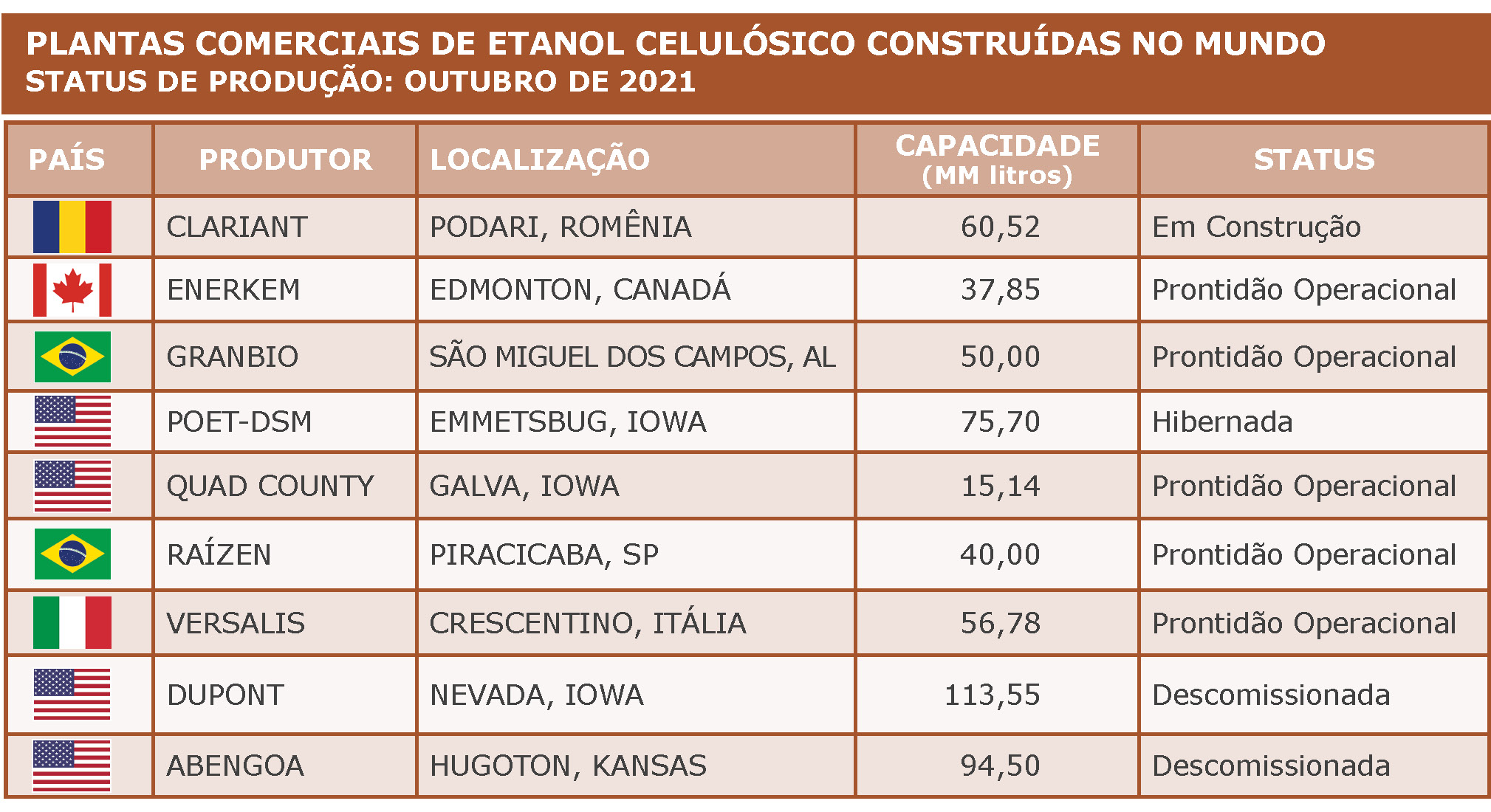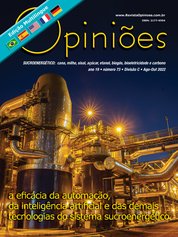Antonio Alberto Stuchi
Consultant in technologies of the sugar-energy sector
OpAA73
Consolidation of second generation ethanol production technology, challenges and opportunities
As a result of photosynthesis, plants basically produce sugars, which are mainly used as a source of energy for their processes, but a part of these sugars is polymerized and used in the structure of plants.
In the sugar and ethanol industry (First Generation), we basically use the sugars that the plant stores for periods of need. The second generation ethanol process proposes to break down the polymers of the plant structure and use the monomers (glucose and xylose) to produce ethanol.
Lignocellulosic biomass consists of three main components: cellulose (polymer of C6 glucose), hemicellulose (mixed polymer of C6 and C5 xylose) and lignin (polymer of alcohols, Guaiacol, Syringol and Catechol ). Second-generation ethanol is produced from the sugars of cellulose and hemicellulose , and lignin is obtained unchanged in a solid state.
As we can see in the highlighted table, some attempts have been made in recent years, not only with laboratory research, but also with the construction of plants on an industrial scale.

EVOLUTION:
The implementation decision was taken by Raízen in 2012, and, in 2013, the first tests of the technology and the plant were started. In 2022, the plant is already operating at its nominal biomass processing capacity, and the ethanol yield per ton of biomass is already around 90% of the projected. The next phase is to fine-tune the processes and check the efficiency gaps at each stage.
The evolution of production went through several stages.
Pre-treatment: a series of problems occurred at the beginning of the operation, mainly regarding the adjustment of the process parameters and corrosion of the equipment.
Lignin separation: Lignin separation originally provided for the use of plate filters, but the project had to be changed.
Fermentation: Fermentation has had good results since the beginning of the operation; the decision was made for a process without recirculation of yeast, similar to fermentation in the corn industry.
Vinasse: The second-generation ethanol plant was designed to operate for at least 300 days a year, and vinasse production in the off-season represented a major challenge to be overcome. The way to the solution passed through the concentration of vinasse.
Maintenance: A process with different requirements from the first generation and continuous operation throughout the year required the elaboration of a special maintenance project.
CHALLENGES:
In a developing technology, innumerable challenges present themselves, and how to manage actions to prioritize them is fundamental for the rapid achievement of project objectives.
Auxiliary equipment: A part of the projected equipment has design and specifications designed for the project, such as biomass pre-treatment, enzymatic reactors, fermenters and yeast multipliers. A range of other equipment in common use in the industry, such as filters, centrifuges, evaporators and pumps, need a careful selection process.
Training people: A major challenge for projects with new technology is training the people who will take care of the operation, maintenance, control and projects. This work begins during tests at the pilot plant, with monitoring of the engineering and construction of the plant.
First generation, second generation integration: This is, without a doubt, one of the biggest challenges for the implementation of the second generation: the fact that the integration between the two plants is essential for the success of the project.
Separation and use of Lignin and C5, C6: Problems observed in pre-treatment, corrosion and erosion also affected the separation processes.
OPPORTUNITIES:
Raw material: Adapting the second generation process to different raw materials can be a great opportunity for business consolidation. Considering only the possibilities of the sugar-energy sector , we basically have three raw materials to check: bagasse, straw and energy cane.
Lignin: The main by-product of the production of Second Generation Ethanol is lignin, a polymer consisting basically of three aromatic alcohols. In Raízen 's second-generation ethanol project, lignin is obtained in a solid state, facilitating its direct use as a fuel, which guarantees the energy supply to the plant. Alternatives to lignin are direct use as a polymer additive; after the depolymerization process, use aromatic monomers to replace products of fossil origin and carbonaceous products (carbon fiber).
Biomass conditioning: The main input for the production of second-generation ethanol is biomass, which will be the decisive factor in choosing where to install the factories. The sugar and ethanol sector is naturally an exceptional candidate for the implementation of second-generation ethanol : first, due to the abundant compulsory production of biomass, and, secondly, due to the synergy between the first-generation and second-generation plants, mainly in terms of the economic use of residues (vinasse) and energy. The challenges for using straw and bagasse to manufacture second-generation ethanol begin with the logistics of collecting and storing sugarcane straw. Harvesting straw in the field (baling) and harvesting whole cane (cane plus straw at harvest). Both processes have their pros and cons and are in the development stage.
Enzymes: This is the main and most expensive input in second-generation ethanol and the main point of speculation about the economic viability of the process. The good news is that the results obtained are within the design parameters, but the need to reduce costs is paramount, and the alternatives for this may be the nationalization of production, dedicated factories and close to the user and increased competition.
Efficiency increase: By-products of pre-treatment, such as acetic acid and furfurol , currently considered inhibitors for fermentation and enzymatic hydrolysis, can be used with the evolution of technology. The optimization of energy consumption is of great importance for the project, and some points can already be enumerated, such as the reuse of heat in the process and optimization of the evaporation of C5 and C6 with the use of lower temperature vapors. Fermentation was another big piece of good news in the second-generation ethanol process ; the initial yields were already very encouraging, but it still remains to improve the alcohol content of the wine, which directly implies the consumption of energy and the production of vinasse.
Materials and engineering: The aggressive characteristics of the pre-treatment (pH, temperature, inorganic contaminants) demand special material solutions for the equipment. We will have a very large project development, with the selection of different materials and engineering solutions for each need. One item that proved to be very important is the need for initial treatment of the biomass to remove mineral impurities and granulometric standardization, which should be an important factor for cost reduction for the initial implementation and maintenance of the project. Finally, the nationalization of equipment production can encourage the emergence of suppliers that will contribute with good solutions.
Conclusion: The availability of surplus biomass associated with the production of sugarcane can be very attractive for the implementation of a second generation ethanol plant attached to the first generation. The ethanol produced can be classified as an “advanced” renewable fuel, and market demands are growing, especially in Europe, the United States and Asia, especially encouraged by legal provisions.
The project implemented at Raízen is already in commercial production, obviously with some adaptations to be completed and with a series of opportunities for improvement. The results obtained already guarantee security to place the expansion of the second generation ethanol project; this decision, already taken by Raízen , will trigger the development of suppliers for equipment and inputs, which, in the future, will present new solutions for products and processes, thus increasing the efficiency of the project.
Finally, the use of surplus biomass can help to dilute the cost of sugarcane production, in this case providing a significant increase in the yield of products per hectare.




